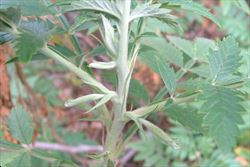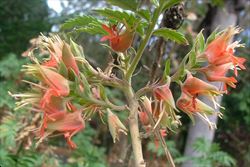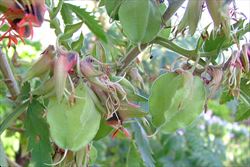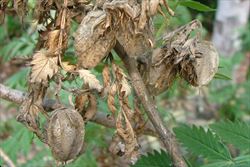Click on images to enlarge

habit (Photo: Sheldon Navie)

hairy stem (Photo: Sheldon Navie)

leaves (Photo: Sheldon Navie)

close-up of leaf showing the winged leaf stalk and toothed leaflets (Photo: Sheldon Navie)

flower clusters in the upper leaf forks (Photo: Sheldon Navie)

close-up of flowers (Photo: Sheldon Navie)

immature fruit (Photo: Sheldon Navie)

mature fruit (Photo: Sheldon Navie)

seedlings (Photo: Sheldon Navie)

young plant (Photo: Sheldon Navie)
Scientific Name
Melianthus comosus Vahl
Family
Melianthaceae
Common Names
Cape honey flower, don't touch me, honey bush, kruidje-roer-my-nie, touch-me-not, tufted honey flower, tufted honey-flower, tufted honeyflower
Origin
Native to south-western Africa (i.e. South Africa, Lesotho and Namibia).
Cultivation
Cultivated as a garden ornamental, particularly in the southern parts of Australia.
Naturalised Distribution
Naturalised in south-eastern Australia (i.e. in south-eastern South Australia and many parts of Victoria).
Habitat
A weed of coastal environs, native bushland, pastures and waterways (i.e. riparian areas) in temperate regions. Potentially also a weed of sub-tropical areas.
Habit
An upright (i.e. erect) and much-branched shrub usually growing 1.2-2 m tall, but occasionally reaching up to 2.5 m in height.
Distinguishing Features
- an upright shrub usually growing 1.2-2 m tall.
- its alternately arranged leaves (up to 20 cm long) are compound with several leaflets that have sharply toothed margins.
- its flowers have a clawed appearance with four red or orange petals of different sizes.
- these flowers emerge from a colourful pouched structure.
- its bladder-like capsules (25-40 mm long) have a net-like surface texture and contain up to eight seeds.
Stems and Leaves
The branching stems are woody near the base of the plant. Younger stems are green and hairy (i.e. pubescent).
The relatively large alternately arranged leaves (10-20 cm long) are borne on winged stalks (i.e. petioles). These leaves are once-compound (i.e. pinnate) and consist of four to seven pairs of leaflets and a single terminal leaflet (i.e. they are imparipinnate). The leaflets are sparsely hairy (i.e. puberulent) on their upper surfaces and downy (i.e. pubescent) on their undersides. Individual leaflets (4-5 cm long and 1-1.5 cm wide) are stalkless (i.e. sessile) and have sharply toothed (i.e. serrated) margins.
Flowers and Fruit
The light red or orange flowers are arranged in loose clusters (i.e. racemes) up to 9 cm long. These flowers are borne on stalks (i.e. pedicels) about 5 mm long amongst small leafy bracts. Each flower has four petals (12-15 mm long) that have a clawed appearance and emerge from a pouched structure (i.e. calyx) made up of the five unequally sized sepals, two of which are larger than the other three. This calyx (10-20 mm long) is pink and greenish in colour, with a dark-red or blackish spot at the base inside. The flowers have four stamens and a four lobed ovary. Flowering occurs mostly during spring (i.e. from August to November).
The fruit is a bladder-like (i.e. inflated), hairy (i.e. pubescent), capsule with a net-like (i.e. reticulate) pattern on its surface. These capsules (25-40 mm long) are four-sided (i.e. quadrangular) in shape and contain up to eight seeds. They turn from green to brown in colour as they mature. The seeds (3-6 mm across) are black or dark brown in colour, almost round (i.e. sub-globose) in shape, shiny in appearance, and smooth in texture.
Reproduction and Dispersal
This species reproduces mostly by seed. The seeds that are contained in bladder-like capsules that can be blown about by the wind and can float on water.
Environmental Impact
Tufted honeyflower (Melianthus comosus) is regarded as an environmental weed in Victoria and South Australia. Infestations of this species may become so dense that they eliminate all other species (i.e. it forms dense monocultures). It most commonly invades coastal habitats and watercourses (i.e. riparian areas) and prefers heavier soils and exposed sites.
The largest reported infestation of this species is located in coastal vegetation in the Lands End restoration area at Cape Jervis in South Australia. Tufted honeyflower (Melianthus comosus) has invaded several hectares of remnant vegetation at this site and is being actively controlled by community groups. It is also present in other parts of south-eastern South Australia (e.g. in Cleland Conservation Park in the Adelaide Hills).
Tufted honeyflower (Melianthus comosus) is also present in conservation areas in Victoria (e.g. in McFarlanes Swamp in Discovery Bay Coastal Park and in Brisbane Ranges National Park), and is regarded as a potentially serious environmental weed in these areas. Infestations present along Little River, in Wyndham City, in western Melbourne have also been targeted for control. This species has also been actively controlled in Murramarang National Park in the Eurobodalla Shire in southern New South Wales.
Other Impacts
Tufted honeyflower (Melianthus comosus) can quickly take over pastures and can seriously reduce productivity in invaded areas.
Legislation
This species is declared under legislation in the following states and territories:
- Victoria: P2 - prohibited and must be eradicated or controlled (in the Goulburn and West Gippsland regions), and C1 - all reasonable steps must be taken to control the weed and prevent its spread (in the Glenelg region only).
- Western Australia: Prohibited - on the prohibited species list and not permitted entry into the state.
Similar Species
Tufted honeyflower (Melianthus comosus) is relatively similar to Cape honeyflower (Melianthus major). However, Cape honeyflower (Melianthus major) can be easily distinguished by its much larger leaves that can grow up to 1 m in length. Also, its flowers are reddish-brown in colour and are borne in larger, dense, nodding clusters.

